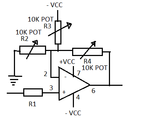skarthikshines
Member level 5
hi all.
am a beginneer for R&D DESIGN . am using MSP430 for my project so its contain fully 3.3 v operation.so here how can i give the port protection for my micro-controller. my analog in put voltage will be (0 to 10)v.. i searched in net and i gave the 3.3v zen er diode for port protection. but the problem is while i giving the 10 v for zener its getting drived for 3.2 v even so am getting 100mv error.. how can i solve this..and suggest me any other efficient port protection method ??
am a beginneer for R&D DESIGN . am using MSP430 for my project so its contain fully 3.3 v operation.so here how can i give the port protection for my micro-controller. my analog in put voltage will be (0 to 10)v.. i searched in net and i gave the 3.3v zen er diode for port protection. but the problem is while i giving the 10 v for zener its getting drived for 3.2 v even so am getting 100mv error.. how can i solve this..and suggest me any other efficient port protection method ??



